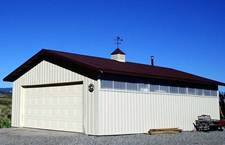Nothing is worse than a roof gone wrong. Leaks frustrate everyone involved, and are usually avoidable. Poor design and poor installation are equal factors in the roofs which just are not happy.
Avoid Valleys
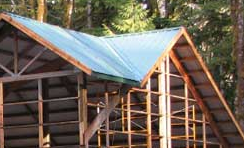 Designing the roof of a pole barn? Then try to design a roof without any valleys. Valleys concentrate water and often clog with ice. It’s far more common to have leaks or ice dam problems near valleys than in the middle of a simple gabled roof. Many valleys exist because of a designer’s conceit rather than necessity. Often, these valleys trace back to the mistaken belief a chopped-up, complicated, multi-plane roof looks better than a simple gable. It doesn’t. And more complicated roofs are more expensive.
Designing the roof of a pole barn? Then try to design a roof without any valleys. Valleys concentrate water and often clog with ice. It’s far more common to have leaks or ice dam problems near valleys than in the middle of a simple gabled roof. Many valleys exist because of a designer’s conceit rather than necessity. Often, these valleys trace back to the mistaken belief a chopped-up, complicated, multi-plane roof looks better than a simple gable. It doesn’t. And more complicated roofs are more expensive.
Just say no to Dormers and Skylights
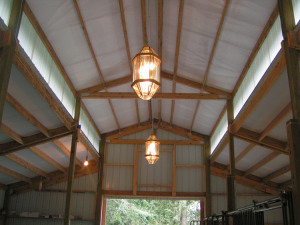 No good reason exists for a new pole building to have a dormer. When I see a dormer, I conclude the designer or the architect made a mistake. They didn’t include enough interior space, and the building owner was forced to cut a hole in the roof because the ceiling was too low to stand up. Want to build a multi-story pole building – no problem. Want two floors, build two floors. Want three floors, build three floors. Then build a roof over the top floor. This roof should not have any deliberate holes in it. The “no holes” rule covers both dormers and skylights. Skylights are an invitation to leak – no matter how great the flashing kit is, pretty well plan upon them leaking, if they don’t it is a surprise bonus.
No good reason exists for a new pole building to have a dormer. When I see a dormer, I conclude the designer or the architect made a mistake. They didn’t include enough interior space, and the building owner was forced to cut a hole in the roof because the ceiling was too low to stand up. Want to build a multi-story pole building – no problem. Want two floors, build two floors. Want three floors, build three floors. Then build a roof over the top floor. This roof should not have any deliberate holes in it. The “no holes” rule covers both dormers and skylights. Skylights are an invitation to leak – no matter how great the flashing kit is, pretty well plan upon them leaking, if they don’t it is a surprise bonus.
In most cases Single Slope Roofs are not less expensive
They also create a very tall wall on one side of the building, which has to be engineered for. Lots of “dead air” space ends up being paid for. There is not a ridge which can be easily vented. Worst of all – most people find them aesthetically unattractive.
An Unconditioned Vented Attic is better than an Insulated Roof
It makes more sense to put insulation on a flat ceiling than to try to insulate a sloped roof, for several reasons. Purlins usually aren’t deep enough to hold a thick layer of insulation; on the other hand, it’s usually easy to add a deep layer of insulation to the attic floor. Insulating the attic floor is also cheaper. Leave the space between purlins uninsulated, it will be easier to locate roof leaks. It is easier to air seal a flat ceiling, rather than a vaulted ceiling. If roof sheathing is used, damp roof sheathing will dry out quicker if it faces an attic than if it is part of a cathedral ceiling.
The Best Roof Shape is a simple Gable Roof
In a cold climate, the ideal design is a simple gable. Since gables don’t have any valleys or hips, they are easy to vent. It’s a straight shot from the soffits to the ridge. Chopped-up roofs with a variety of intersecting planes are hard to frame, hard to keep watertight, and hard to vent. Every nook and cranny creates somewhere for tree needles and ice to accumulate.
In a hot climate, a hipped roof can make more sense than a gable, because a hipped roof makes it easier to provide shade on all four sides of the pole barn. In a hot climate, shade is good. Fortunately, people in hot climates rarely have to worry about ice dams.
In all climates, make overhangs generous. If building a gable roof, don’t forget the rake overhangs; most rake overhangs are too stingy. Frame the rake overhang with overhanging purlins.
Don’t reduce the Roof Slope between the Ridge and the Eave
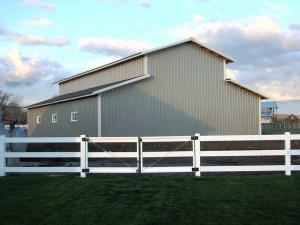 A good roof plane has a consistent slope from the ridge to the eave. A roof which changes slope at midpoint is disturbing. Especially disturbing is a steep roof which suddenly switches to a shallow pitch (for example, when a porch with a shallow-pitched roof is affixed to a pole building with a steep roof). Shallow slopes hold snow and are susceptible to leaks. Most steel roofing warranties are void on slopes of less than 3/12.
A good roof plane has a consistent slope from the ridge to the eave. A roof which changes slope at midpoint is disturbing. Especially disturbing is a steep roof which suddenly switches to a shallow pitch (for example, when a porch with a shallow-pitched roof is affixed to a pole building with a steep roof). Shallow slopes hold snow and are susceptible to leaks. Most steel roofing warranties are void on slopes of less than 3/12.
Make sense so far? Come back Monday when I finish up on my recommendations for making your roof affordable, long lasting, and pleasing to the eye.
 Skylights in steel roofs are problematic, and not just due to them eventually leaking. You will certainly want to read this article: https://www.hansenpolebuildings.com/2016/01/one-more-reason-to-not-use-skylights-in-steel-roofs/.
Skylights in steel roofs are problematic, and not just due to them eventually leaking. You will certainly want to read this article: https://www.hansenpolebuildings.com/2016/01/one-more-reason-to-not-use-skylights-in-steel-roofs/.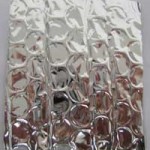 Everyone says to put on single or double bubble before putting down roof metal but if I do that how do I insulate the ceiling because then I will have a vapor barrier above the insulation. DAVID in KIRKWOOD
Everyone says to put on single or double bubble before putting down roof metal but if I do that how do I insulate the ceiling because then I will have a vapor barrier above the insulation. DAVID in KIRKWOOD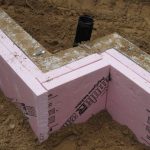 Thank you, CHRIS in NEW HOLLAND
Thank you, CHRIS in NEW HOLLAND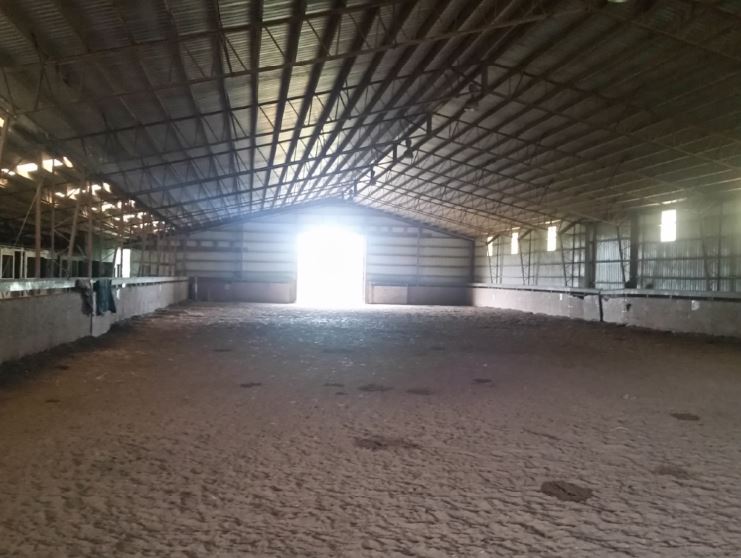
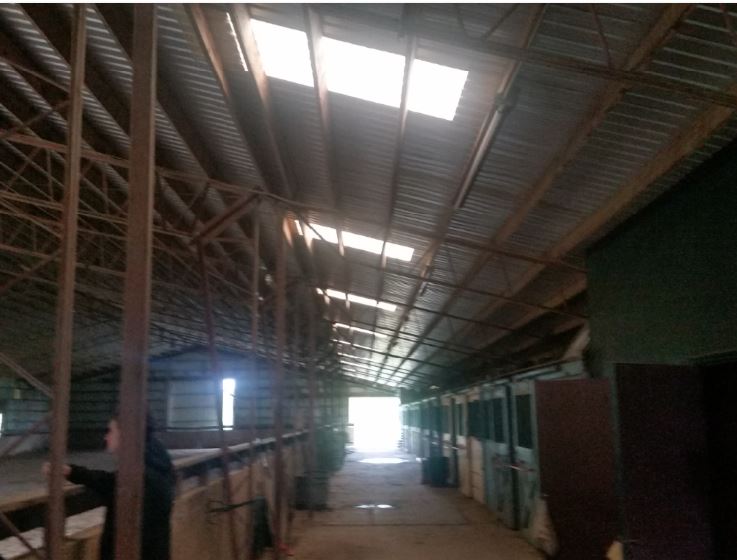
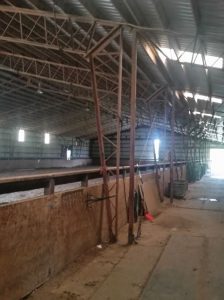 Some observations from your photos – minor discolorations appearing as “runs” down sides of roof purlins are due to condensation. No steel roofed building should be constructed without some sort of mechanism to minimize condensation. Only realistic fix for future condensation control would be to have closed cell spray foam insulation placed below roof surface. This insulation should be a minimum thickness of two inches and in most areas a going rate of about a dollar per square foot, per inch of thickness. You could be seeing a $30,000 bill.
Some observations from your photos – minor discolorations appearing as “runs” down sides of roof purlins are due to condensation. No steel roofed building should be constructed without some sort of mechanism to minimize condensation. Only realistic fix for future condensation control would be to have closed cell spray foam insulation placed below roof surface. This insulation should be a minimum thickness of two inches and in most areas a going rate of about a dollar per square foot, per inch of thickness. You could be seeing a $30,000 bill.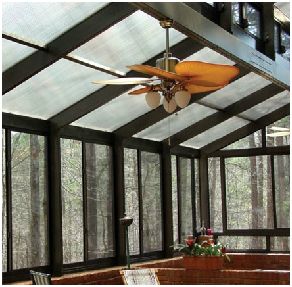 Hansen Pole Buildings recently had an inquiry from a client who wants to construct a greenhouse 24’ wide by 30’ long with eight foot sidewalls. The client specified the use of triple wall polycarbonate panels for roofing. Since I was unfamiliar with the product, it was research time.
Hansen Pole Buildings recently had an inquiry from a client who wants to construct a greenhouse 24’ wide by 30’ long with eight foot sidewalls. The client specified the use of triple wall polycarbonate panels for roofing. Since I was unfamiliar with the product, it was research time.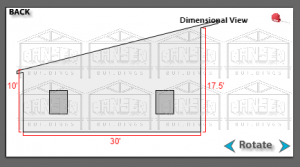 “I will be building a single slope (roof and 3 sides covered with corrugated steel) pole barn similar to one of your designs online. My ideal design is 20 by 30 with 1 foot roof overhang. The structure consists of (3) 20 x 10 bays. High side to be 12 feet and low side to be 10 feet with bay entry at high side. I will only consider steel posts (8) for the vertical pole construction. For the roofing material please include 2 each opaque roof sheathing for each bay (natural lighting). Design to include high wind (50 mph) with 18″ snow load. Please provide a detailed bill of material including foundation (30 to 36 inch footing depth (no slab) with bid. I will be requesting engineered drawings. The shipping destination is xxxxx zip code so please include shipping total and tax in bid.
“I will be building a single slope (roof and 3 sides covered with corrugated steel) pole barn similar to one of your designs online. My ideal design is 20 by 30 with 1 foot roof overhang. The structure consists of (3) 20 x 10 bays. High side to be 12 feet and low side to be 10 feet with bay entry at high side. I will only consider steel posts (8) for the vertical pole construction. For the roofing material please include 2 each opaque roof sheathing for each bay (natural lighting). Design to include high wind (50 mph) with 18″ snow load. Please provide a detailed bill of material including foundation (30 to 36 inch footing depth (no slab) with bid. I will be requesting engineered drawings. The shipping destination is xxxxx zip code so please include shipping total and tax in bid. Designing the roof of a pole barn? Then try to design a roof without any valleys. Valleys concentrate water and often clog with ice. It’s far more common to have leaks or ice dam problems near valleys than in the middle of a simple gabled roof. Many valleys exist because of a designer’s conceit rather than necessity. Often, these valleys trace back to the mistaken belief a chopped-up, complicated, multi-plane roof looks better than a simple gable. It doesn’t. And more complicated roofs are more expensive.
Designing the roof of a pole barn? Then try to design a roof without any valleys. Valleys concentrate water and often clog with ice. It’s far more common to have leaks or ice dam problems near valleys than in the middle of a simple gabled roof. Many valleys exist because of a designer’s conceit rather than necessity. Often, these valleys trace back to the mistaken belief a chopped-up, complicated, multi-plane roof looks better than a simple gable. It doesn’t. And more complicated roofs are more expensive. A good roof plane has a consistent slope from the ridge to the eave. A roof which changes slope at midpoint is disturbing. Especially disturbing is a steep roof which suddenly switches to a shallow pitch (for example, when a porch with a shallow-pitched roof is affixed to a pole building with a steep roof). Shallow slopes hold snow and are susceptible to leaks. Most steel roofing warranties are void on slopes of less than 3/12.
A good roof plane has a consistent slope from the ridge to the eave. A roof which changes slope at midpoint is disturbing. Especially disturbing is a steep roof which suddenly switches to a shallow pitch (for example, when a porch with a shallow-pitched roof is affixed to a pole building with a steep roof). Shallow slopes hold snow and are susceptible to leaks. Most steel roofing warranties are void on slopes of less than 3/12.